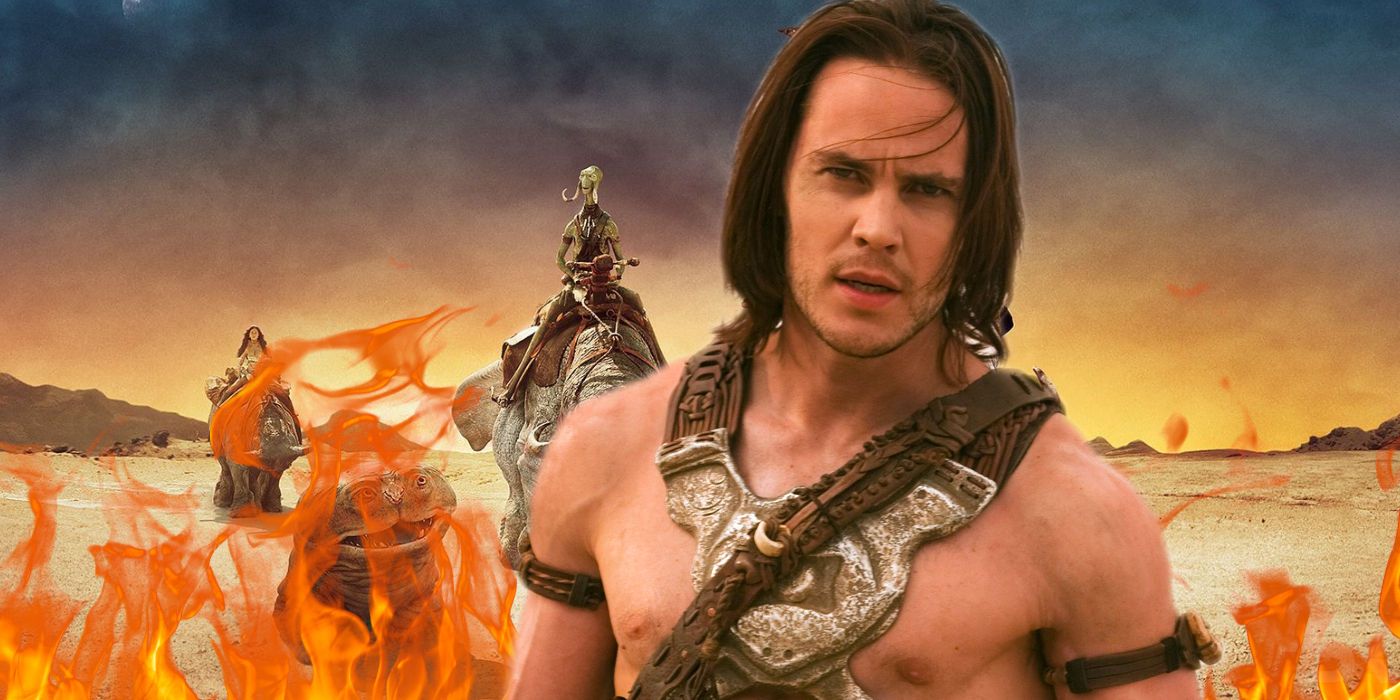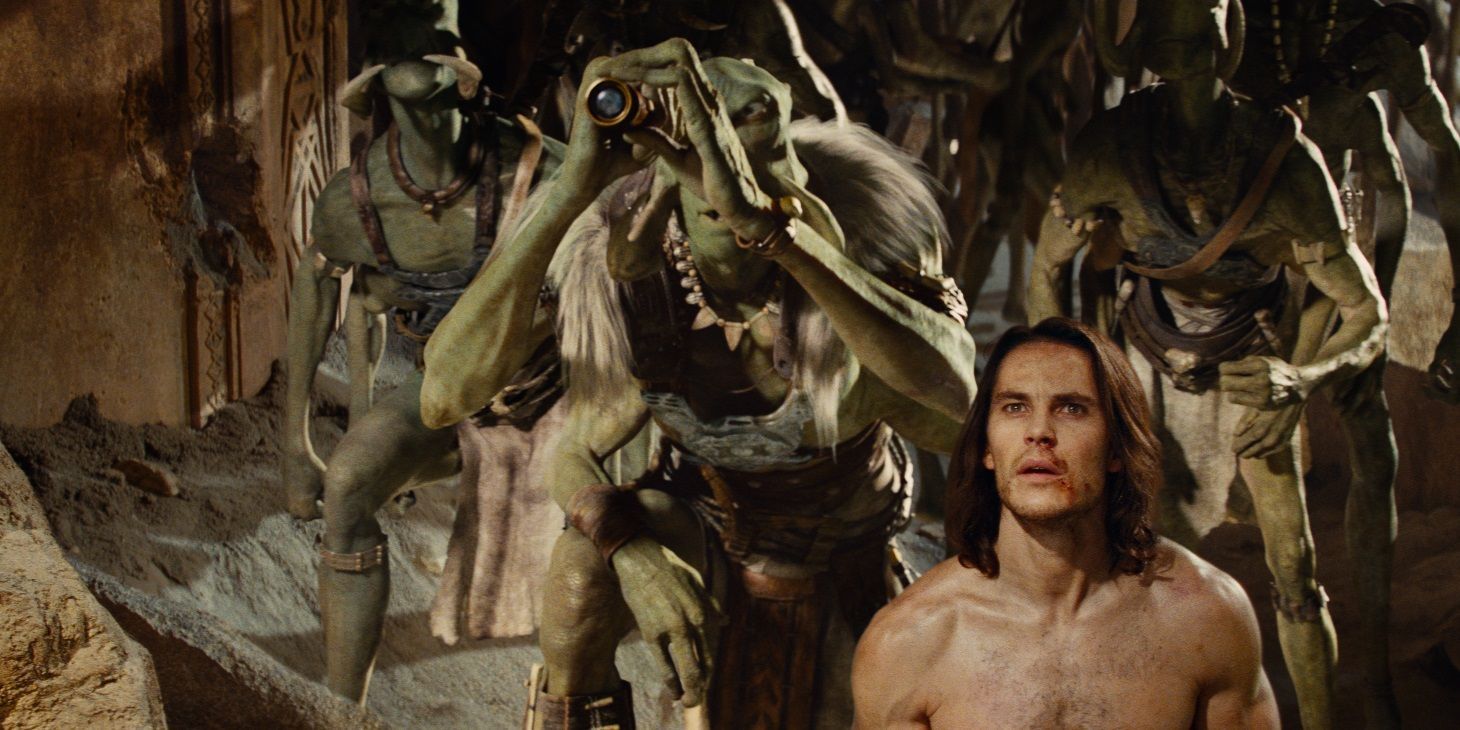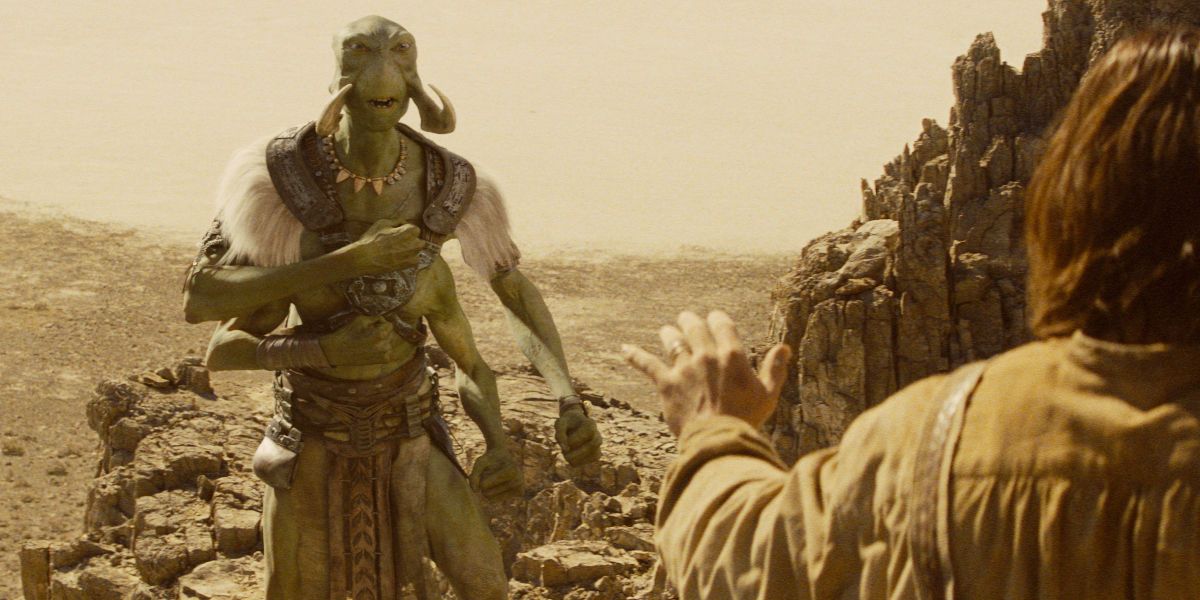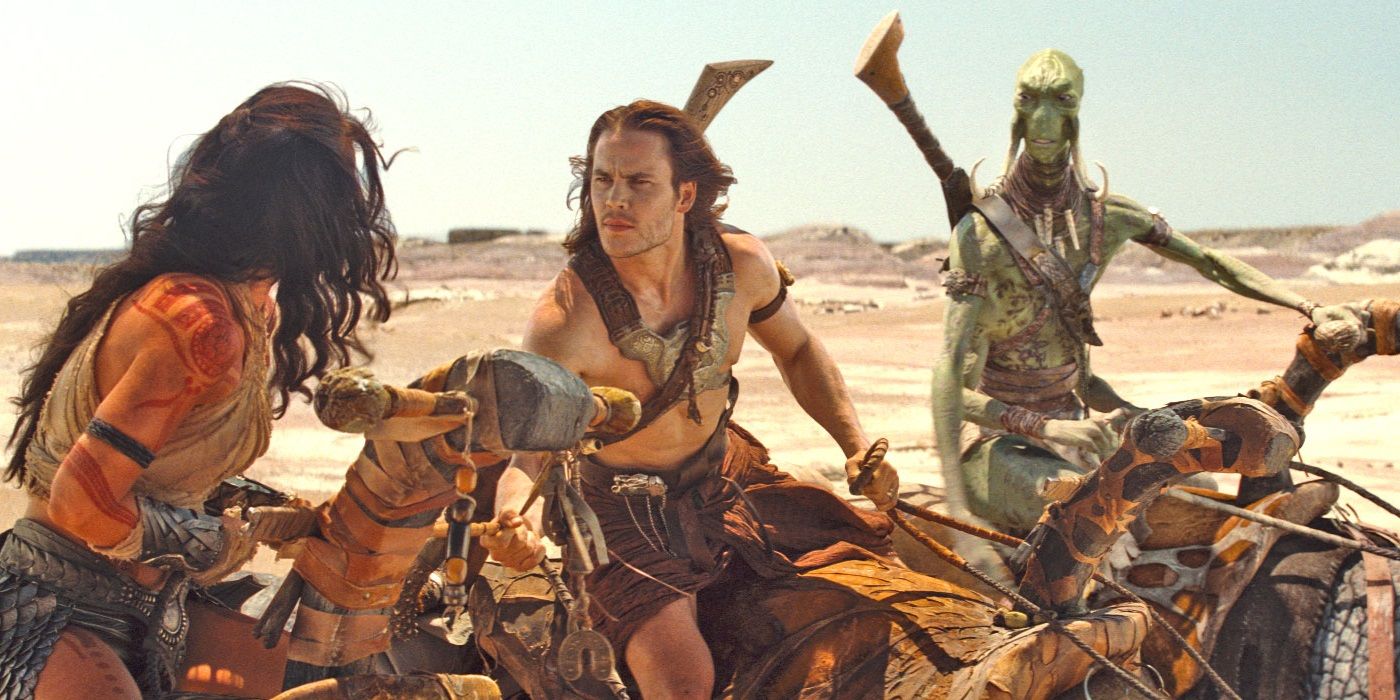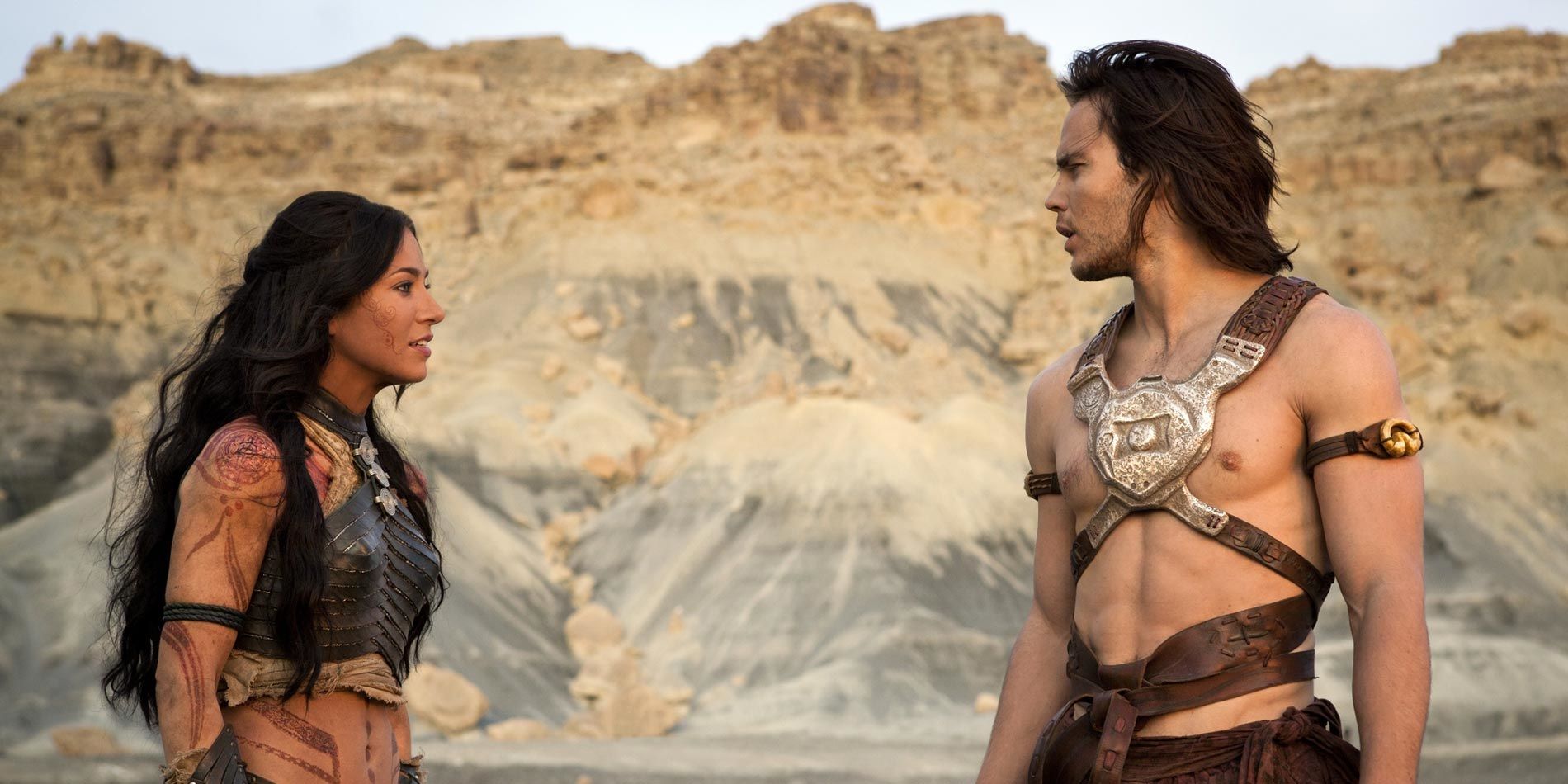John Carter remains one of Disney’s biggest and costliest flops, and here's everything that went wrong with making the movie. The 2012 sci-fi action movie, based on the influential Barsoom series by Edgar Rice Burroughs, was intended as a lavish, big-budget, CGI-heavy extravaganza that would allow the studio to keep up with the likes of Marvel, James Bond, and Star Trek at the time.
Disney pumped everything they had into the John Carter movie: an Oscar-winning director; an up-and-coming leading man surrounded by industry buzz; one of the biggest reported budgets ever for a live-action movie; and more than 2,000 visual-effects shots. It was meant to be a sure-fire hit, a blockbuster to rival the likes of The Avengers and The Hobbit trilogy. Instead, it led to Disney reporting a $200 million write-down on the movie. With a total cost of $350 million, including an estimated production budget of $263 million, John Carter only made $284.1 million worldwide.
The financial failure of John Carter has come to exemplify Disney’s current mold of business: remakes, reboots, and acquisitions are safe investments, but trying to establish new franchises and blockbuster tentpoles outside of those familiar nostalgic properties is where disaster lies. This notably happened with movies like A Wrinkle in Time, Tomorrowland, The Lone Ranger, The Nutcracker and the Four Realms, and, most recently, Artemis Fowl. What should have been another display of Disney’s indomitable strength quickly became a cautionary tale. So, why exactly did John Carter flop as spectacularly as it did?
John Carter Wasn't A Popular Enough Brand To Be Successful
The Barsoom series by Burroughs was a popular pulp saga of sci-fi fantasy published between 1912 and 1948. While these tales of aliens on Mars never became as ubiquitous as Burroughs's other major creation, Tarzan, they still wielded a mighty influence over the next century of science-fiction as a whole. Authors such as Arthur C. Clarke, Ray Bradbury, and Robert A. Heinlein were heavily inspired by the Barsoom books, as were stories like Star Wars, Avatar, and Babylon 5. Burroughs's stories of Mars were so beloved that the author even has a real crater on the planet named after him!
However, the work itself has, over the decades, mostly been overlooked in favor of that which it influenced. To audiences of the 2010s, John Carter and Barsoom aren’t recognizable properties. It’s not impossible to launch a nine-figure blockbuster based on such material but, as people have seen over the past decade, it’s become increasingly difficult to make big bucks with movies that aren’t either superhero movies, Star Wars sequels, remakes of Disney cartoons, or reboots of nostalgic fare. There may be some die-hard Barsoom fans out there but it’s doubtful there was enough of them in those key demographics Disney appeal to in order to justify such a costly endeavor. Name recognition alone does not make a movie hit. Just ask the most recent Tarzan reboot for evidence of that, or Disney’s own attempt to make The Lone Ranger a 21st century action favorite.
John Carter Focused Too Much On Setting Up A Sequel
One of the major stumbling blocks for wannabe franchises of the past decade has been the misguided desire to replicate the mold pioneered by superhero movies. Given that, by the time John Carter premiered in 2012, major superhero movies such as the X-Men films, The Dark Knight trilogy, and the burgeoning Marvel Cinematic Universe had already seen enormous success and helped to dramatically change the blockbuster game, it’s not hard to see why such prospects would be tantalizing to studios, including to Disney themselves. If they made it work with superheroes then why not try it out with one of the stories that helped to lay the groundwork for that genre?
In an effort to play catch-up to a franchise that spent years developing its intricately woven multiple narratives, many studios tried to do the work of three or four movies in one. This resulted in a lot of franchise non-starters because audiences had little interest in films that existed solely to set up a bunch of sequels for a property they didn’t care about. This happened Artemis Fowl as well as expanded universes such as Robin Hood and King Arthur: Legend of the Sword. John Carter fell into a similar set of problems. While there was some joy to be found in watching the lavishly depicted world of Barsoom be unveiled to viewers, it wasn’t enough to sustain a movie and didn’t entice enough people to invest in a trilogy that would never see the light of day.
John Carter Was Filmed Like An Animated Movie, Not Live-Action
John Carter was the dream child of Andrew Stanton, one of the first employees of Pixar and the Oscar-winning director of WALL-E and Finding Nemo. Stanton was such a fan of Burroughs' work that he lobbied Walt Disney Studios to re-acquire the film rights to the Barsoom stories, which they had initially owned in the 1980s following failed plans to create their own competitor to Star Wars. Stanton then landed the director gig for the movie despite never having made a live-action film before. He was considered a safe bet in large part because of the money his animated films had made for the company over the years.
In fairness, it certainly made sense to let someone used to working with thousands of visual-effects shots take the reins of a project that demanded such an extensive amount of CGI. However, even Stanton himself would admit that his inexperience in the live-action medium had caused problems for Disney and the movie. As he would explain to The New York Times: "The thing I had to explain to Disney was, 'You're asking a guy who's only known how to do it this way to suddenly do it with one reshoot.' I said, 'I'm not gonna get it right the first time, I'll tell you that right now.'"
Stanton attributed his hesitation on such matters to his animation background, and The New York Times reported that he "leaned heavily on his colleagues at Disney-owned Pixar for guidance, paying less attention to input from people with experience in live-action filmmaking." In fairness to Stanton, it seems that he was not suitably supported by the top managers at Disney at the time, who also did not possess much experience in working with these massive live-action blockbusters. The end result was essentially a movie that had been filmed as an animated project rather than tackled as a movie meant to be live-action; while there are similarities in the process, they are still fundamentally different.
John Carter's Budget Made It Tough To Be Successful
It's now not only common to see movies with reported budgets between $200 and 300 million but it's also the norm for many of these studio tentpole titles. All but one of the ten most expensive films ever made were released in the past decade, and Disney produced eight of them. This is now the status quo for blockbuster cinema, an era of too-big-to-fail filmmaking that is almost exclusively reliant on international grosses just to break even. John Carter, which is ninth on that list thanks to its net budget of just under $264 million, is the only film of those ten that wasn’t part of a pre-established franchise. Even if it were, throwing a quarter of a billion dollars at any movie in 2012 was a dire risk.
A film costing $264 million needs to make, at the very least, $660 million worldwide to break even. Realistically speaking, Disney was probably hoping that John Carter would bring in closer to $800 million or so. And the fact of the matter is, only a few dozen films ever produced, by that point in time, had earned that amount of money at the box office. Making a proper adaptation of the epic Barsoom stories required that level of financial and creative investment but audiences are less impressed by these overwhelming displays of CGI and sci-fi grandeur nowadays. To put it bluntly, audiences had seen it all before by the time John Carter released.
John Carter Had A Terrible Marketing Campaign
John Carter's failure can’t be put at the feet of one specific aspect of the movie but its endless stumbles in the marketing department certainly made its journey to success all the more unattainable. First, the decision to take a story originally titled A Princess on Mars only to change it to John Carter of Mars raised a lot of questions over who Disney wanted to sell the movie to. Oft-refuted Hollywood logic insists that stories about men are universally appealing while stories about women are only interesting to other women, although that’s never stood up to scrutiny at Disney given how they established their decades-long brand off the backs of princess stories. Andrew Stanton took it even further by dropping the “of Mars” part of the title altogether, claiming that it made more sense for the character and would help the movie appeal to a broader audience. Instead, it robbed the movie of its identity. John Carter as a title conveyed nothing to potential audiences about the movie they were being sold.
Matters weren't helped by the movie's overall promotion. Stanton pushed for marketing ideas that, according to those who worked on the movie, failed to convey the necessary message. Ideas such as the choice of using Led Zeppelin's song "Kashmir" in the trailer made the film seem more retro than desired. The trailers didn't excite, nor did the preview reel put together for fans at D23 in 2011. By the time the movie released, Variety lamented that John Carter was being “treated like a corpse”, a flop-in-waiting that everyone, from fans to critics to Disney themselves, was ready to dismiss as a failure. In the end, it didn’t even matter that the reviews for John Carter were relatively strong. There was simply no enthusiasm around it and audiences caught on quickly that this movie, as expensive and hotly hyped as it was, would not be the epic hit that the studio was hoping for. After John Carter disappeared from theaters, Disney allowed the rights to the Barsoom stories to revert back to Edgar Rice Burroughs’ estate, putting the final nail in the coffin of Andrew Stanton’s dream for an immense Mars saga.

